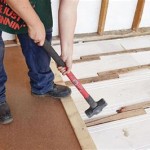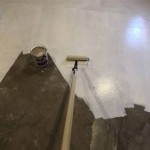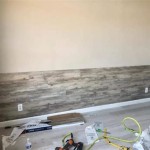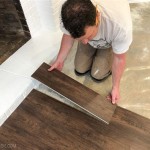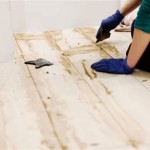Cost To Replace Vinyl Bathroom Floor
Replacing a vinyl bathroom floor is a common home improvement project undertaken for various reasons, ranging from aesthetic upgrades to addressing wear and tear. Understanding the costs associated with this project is crucial for budgeting and planning. Several factors influence the overall expense, including the type of vinyl flooring chosen, the size of the bathroom, the complexity of the installation, and whether professional installation is required.
This article aims to provide a comprehensive overview of the costs involved in replacing a vinyl bathroom floor. It will break down the different components of the total cost, explore the various types of vinyl flooring available, and discuss ways to potentially save money on the project. By understanding these elements, homeowners can make informed decisions and effectively manage their bathroom renovation budget.
Factors Influencing Vinyl Flooring Replacement Costs
Several key factors contribute to the overall cost of replacing a vinyl bathroom floor. Ignoring these factors can lead to inaccurate budget estimations and unexpected expenses. These factors include material costs, labor costs (if using professionals), the size and complexity of the bathroom, and any necessary subfloor repairs.
Material Costs: The type of vinyl flooring selected significantly impacts the material cost. Vinyl flooring comes in various forms, including sheet vinyl, vinyl tile, and luxury vinyl planks (LVP). Each type has different price points based on its quality, design, and durability. Sheet vinyl is generally the most affordable option, while LVP tends to be more expensive due to its realistic appearance and enhanced durability. The chosen material's thickness, wear layer, and pattern also contribute to the final price.
Labor Costs: If professional installation is preferred, labor costs will constitute a significant portion of the overall expense. Labor rates vary depending on the installer's experience, location, and the complexity of the installation. Complex bathroom layouts with intricate corners or fixtures that require careful cutting and fitting will likely increase labor costs. Removing the old flooring and preparing the subfloor can also add to the labor time required.
Bathroom Size and Complexity: The square footage of the bathroom directly influences the amount of vinyl flooring required, impacting the material cost. A larger bathroom will naturally require more flooring, leading to a higher overall expense. The bathroom's layout complexity also matters. Bathrooms with numerous corners, built-in cabinets, or unusual shapes require more precise cutting and fitting, increasing both material waste and installation time. Obstacles like toilets and vanities also require additional labor for careful removal and reinstallation.
Subfloor Preparation and Repair: The condition of the subfloor beneath the existing flooring is crucial. If the subfloor is uneven, damaged, or rotted, it will need to be repaired or replaced before the new vinyl flooring can be installed. Subfloor repairs can involve patching holes, leveling uneven surfaces, or replacing entire sections of plywood or concrete. These repairs add to the overall cost and should be factored into the budget from the outset to avoid cost surprises.
Types of Vinyl Flooring and Their Associated Costs
Vinyl flooring is available in several distinct types, each differing in construction, appearance, installation method, and cost. Understanding these differences is essential for selecting the appropriate flooring for the bathroom and managing the project budget effectively. The primary types of vinyl flooring include sheet vinyl, vinyl tile, and luxury vinyl planks (LVP).
Sheet Vinyl: Sheet vinyl is a continuous, large sheet that is typically installed in a single piece, minimizing seams and making it a water-resistant option suitable for bathrooms. Sheet vinyl is generally the most affordable type of vinyl flooring. The cost of sheet vinyl typically ranges from $1 to $5 per square foot for the material itself. Installation costs for sheet vinyl can vary depending on the complexity of the room, but generally range from $2 to $4 per square foot, including labor. The total cost for sheet vinyl flooring installed ranges from $3 to $9 per square foot.
Vinyl Tile: Vinyl tile is available in individual squares or rectangles, allowing for greater design flexibility compared to sheet vinyl. It comes in a variety of styles, including patterns that mimic ceramic tile or stone. Vinyl tile is generally more expensive than sheet vinyl but less expensive than LVP. The material cost for vinyl tile typically ranges from $2 to $7 per square foot. Installation can be done by the homeowner, but professional installation typically ranges from $2 to $5 per square foot. The total cost for vinyl tile flooring installed typically ranges from $4 to $12 per square foot.
Luxury Vinyl Planks (LVP): Luxury vinyl planks (LVP) are designed to mimic the look of hardwood flooring. They are typically thicker and more durable than sheet vinyl or vinyl tile, providing a more realistic appearance and feel. LVP offers excellent water resistance and durability, making it a suitable choice for bathrooms. LVP is generally the most expensive type of vinyl flooring. The material cost for LVP typically ranges from $3 to $10 per square foot. Professional installation is generally recommended for LVP, with costs ranging from $2 to $6 per square foot. The total cost for luxury vinyl plank flooring installed typically ranges from $5 to $16 per square foot.
Estimating the Total Cost of Your Vinyl Bathroom Floor Replacement
Accurately estimating the total cost of a vinyl bathroom floor replacement requires careful consideration of all the factors discussed previously. This includes accounting for material costs, labor costs (if applicable), subfloor repairs, and any additional expenses such as removing the old flooring or disposing of waste. A systematic approach to estimating these costs will help avoid unexpected expenses and ensure that the project stays within budget.
Measuring the Bathroom and Calculating Material Needs: The first step is to accurately measure the square footage of the bathroom. Multiply the length by the width of the room to determine the total square footage. It is advisable to add an extra 10-15% to account for waste, cuts, and potential errors during installation. This ensures sufficient material is available to complete the project properly. For example, if the bathroom is 50 square feet, order at least 55-58 square feet of vinyl flooring.
Obtaining Quotes for Materials and Labor: Once the square footage is determined, it's necessary to obtain quotes for the chosen vinyl flooring material. Compare prices from different retailers and suppliers to find the best deals. When considering professional installation, obtain multiple quotes from qualified contractors. Ensure that the quotes include all costs, such as labor, materials, removal of the old flooring, and disposal of waste. Verify the contractor's licensing, insurance, and references before making a final decision. A detailed and transparent cost breakdown will prevent misunderstandings later on.
Accounting for Subfloor Repairs and Additional Costs: Inspect the subfloor carefully for any signs of damage, such as cracks, rot, or unevenness. If repairs are necessary, obtain separate quotes for these from qualified contractors. Subfloor repairs can range from minor patching to complete replacement, depending on the severity of the damage. Additionally, factor in any other potential costs, such as the cost of removing and disposing of the old flooring, purchasing tools or equipment if attempting a DIY installation, and any unexpected issues that may arise during the project.
Creating a Contingency Fund: It's always recommended to set aside a contingency fund of 10-15% of the total estimated cost to cover unforeseen expenses. Unexpected issues can arise during any home improvement project, and having a contingency fund will provide financial flexibility to address them without derailing the budget. This can cover minor repairs, additional materials, or unforeseen labor costs.
Ways to Save Money on Vinyl Bathroom Floor Replacement
There are several strategies homeowners can employ to save money on a vinyl bathroom floor replacement. These strategies involve making informed decisions about material choices, considering DIY installation, and actively seeking discounts and deals. Careful planning and resourcefulness can significantly reduce the overall cost of the project.
Choosing Affordable Vinyl Flooring Options: Selecting a more budget-friendly type of vinyl flooring, such as sheet vinyl or less expensive vinyl tiles, can significantly reduce material costs. While luxury vinyl planks (LVP) offer a premium look and feel, they also come with a higher price tag. Explore various options and consider trade-offs between aesthetics and cost. Look for sales and discounts on vinyl flooring at local home improvement stores or online retailers.
DIY Installation: Installing vinyl flooring is a project that some homeowners can undertake themselves, particularly with simpler options like peel-and-stick vinyl tiles or click-lock LVP. DIY installation can save a substantial amount on labor costs. However, it is crucial to accurately assess one's skills and experience before attempting a DIY installation. Incorrect installation can lead to issues such as uneven flooring, gaps, or water damage, which could ultimately result in higher costs for repairs or reinstallation. If attempting a DIY installation, thoroughly research the proper techniques and procedures. Watch instructional videos and consult with experienced individuals if necessary. Invest in the necessary tools and equipment to ensure a successful installation.
Negotiating Prices and Shopping Around: Obtain quotes from multiple contractors for both materials and labor. Compare the quotes carefully and negotiate prices where possible. Some contractors may be willing to offer discounts or match competitor's prices. Shopping around and being proactive in negotiating can lead to significant savings. Consider purchasing materials during sales or off-season periods. Home improvement stores often offer promotional discounts on flooring materials, particularly during seasonal sales. Look for clearance items or discontinued styles that may be available at discounted prices.

Average Cost Of Vinyl Flooring Installation In 2024 Forbes Home

Cost To Install Vinyl Plank Flooring A Complete Guide 2024 Forbes Home

Advantages Disadvantages And Types Of Vinyl Flooring

Vinyl Flooring Cost 2024 List Fitting Per Sqm

Fixr Com Cost To Install Vinyl Flooring

Cost To Install Vinyl Floors The Home

How To Install Sheet Vinyl Floor Decor Adventures

Vinyl Flooring Pros And Cons Forbes Home

Cost To Install Vinyl Floors The Home

15 Things To Know Before Installing Vinyl Flooring Or Pvc
See Also

